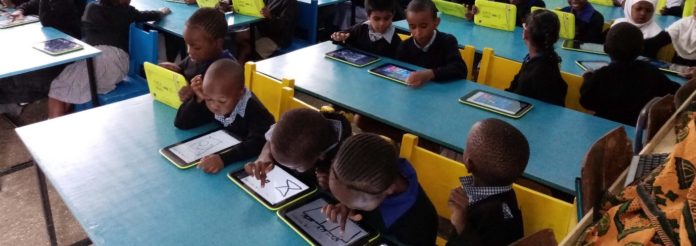By Tebby Otieno
Nairobi, Kenya: The Kenya National Union of Teachers (KNUT), Secretary-General, Wilson Sossion, has termed the famous school laptop project as a scam.
Sossion who is also a Nominated Member of Parliament under the Orange Democratic Movement (ODM), claimed the business flagship in the education sector was used to embezzle billions of shillings.
A spot check on some of the pupils who sat their Kenya Certificate of Primary Education (KCPE), examinations in March this year, were in class one in 2013. This is the year the Digital Literacy Programme (DLP), was initiated by the Government of Kenya.
The program is aimed at integrating the use of technologies in learning in all public primary schools starting with class one.
Many parents in Kenya’s public school sector are yet to see the benefits of this project.
Suzanah Malema, a parent in Nairobi reveals that her firstborn was in nursery school when this announcement was made. Her expectations were that when her daughter progresses in class one the following year, she starts her digital learning journey.
She is still waiting with high hopes that one day, her children will enjoy the computer project.
“To me, it was quite a good initiative that was going to be a positive impact,” She says.
Two of her children are in public primary schools. She says normally they are given assignments by teachers. However, there is a lesson she keeps hoping to see in the home assignments.
“When my children come home, I have never seen any homework related to the digital assignment with them.”
Malema’s family represents many Kenyans who would have loved to see their children access their school lessons online at the cost of the government. Their hopes in the DLP hang in the air.
“My expectations were since this project was being promised to us parents, I was of the opinion that as at this time maybe our children would be competing with those in countries where children are able to access digital platforms at an early stage because maybe their parents are capable,” She says.
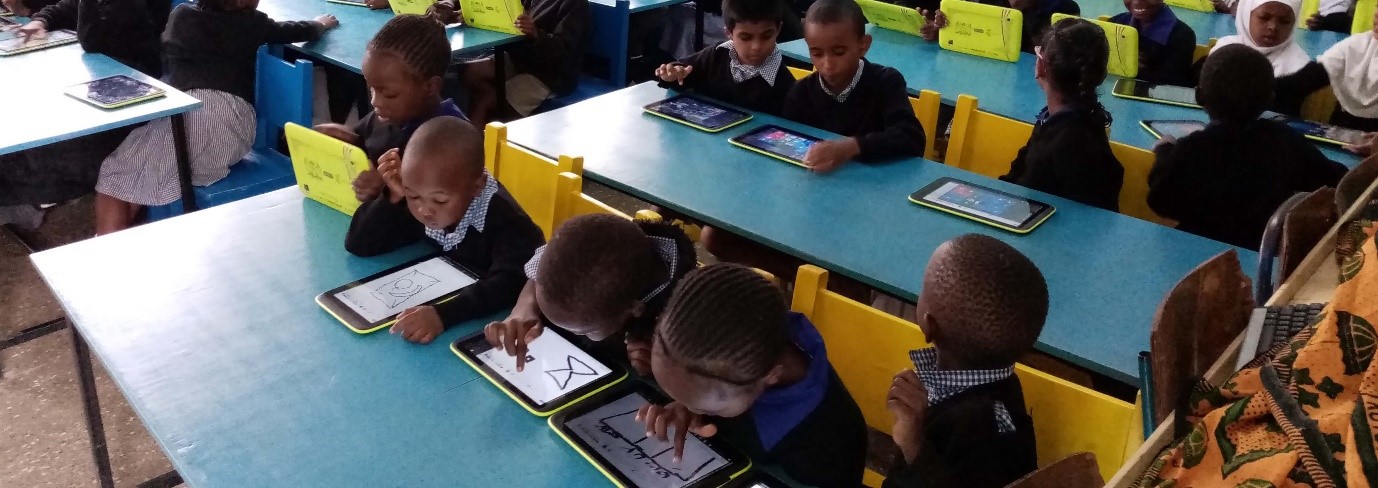
To kick off the program, the Ministry of Information, Communication, and Technology (ICT) was allocated in the medium term about Ksh. 53.2 billion in the 2013/2014 budget.
This amount was meant for the deployment of 1,350, 000 laptops to class one pupils, development of digital content, rolling out of computer laboratories for classes 4 to 8, and building the capacity of teachers in all schools throughout the country.
According to ICT Authority which is implementing DLP, there are 1,169,000 devices distributed to 21,638 public primary schools countrywide and about 91,000 teachers trained on how to use the new technology for teaching and learning.
One of the trained teachers, John* not his real name, reveals that he does not have adequate skills to manage the devices.
“Not all the devices we were given are still functioning. With technology, some of them go out very quickly. For example, what we were given I think it was Window… I don’t know what and now we need to upgrade them. Some of them are on their own as they cannot restart” says John.
The retirement age of public servants and teachers is 60 and 65 years for people with disabilities. Teacher John, reveals to me that he is not far from this age bracket.
“Some of the children miss out when we are unable to reach them because of the overwhelming number. Luckily, I am a retiree, I am almost leaving, I am on the way, it will be soon but the other teacher is young so continuing will be there,” He says.
A report from the ministry of education which was tabled in parliament in 2019, indicated that the laptop program collapsed because teachers were not adequately trained. The Kenya National Union of Teachers (KNUT) Secretary-General, Wilson Sossion, confirms nothing has changed two years later.
“As a union, today teachers have not been trained to be able to deliver through the digital program. What we are getting from ICT is merely public relations to protect government” says Hon. Sossion.
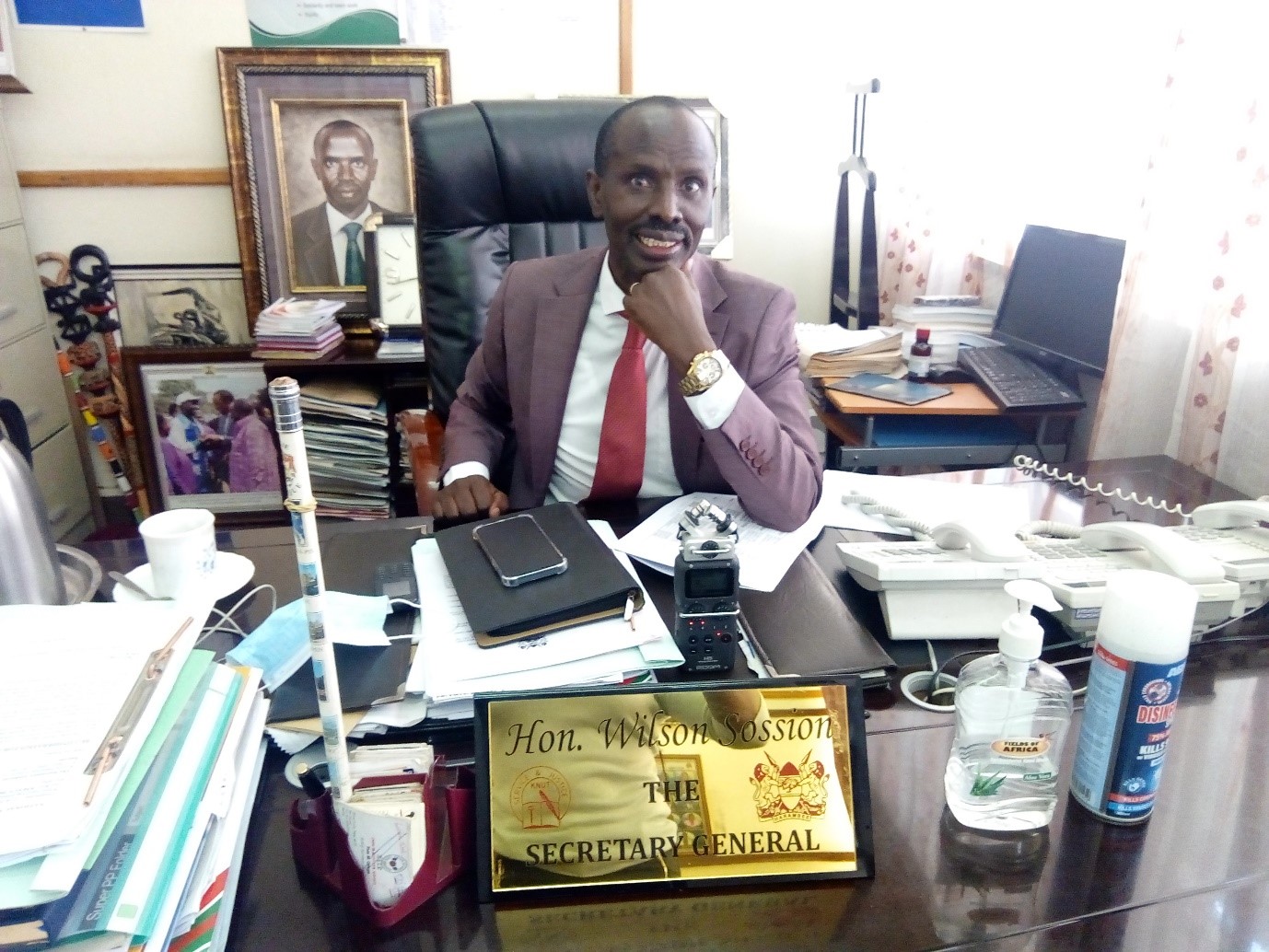
Dealing with the government’s figures much time is a challenge because these figures are given in bulk and it is rarely easy for anybody to know the specifics of what the money was spent on. Bureaucracy also hinders access to information from relevant people and when done, it is given in bulk.
For example, ICT Authority referred me to their website. This was after a follow-up with the relevant staff that lasted almost three months through email, phone calls, and physical office visits.
“Can the government account to us how much one tablet cost. Because over the years, if they can only deliver one million tablets, most of them are faulty and many schools are unable to maintain the electricity cost of recharging them and learners are unable to use them and teachers have no skills to use them, then what are we talking about? That is the fact,” demands Sossion.
According to Sossion, Ksh. 70 billion has been spent on the project since its inception.
“Laptop project was tailored to be a business flagship in the sector that was used to embezzle billions of shillings. The 70 billion shillings we can only conclude that it was stolen and nothing went on in the sector” He says adding that “We cannot be cheated that one million laptops and the program are worth Ksh. 70 billion”
In 2019 the Director Information Communication Technology Authority Programmes and Standards Dr. Kipronoh Rono, told Senate and National Assembly committee on ICT, that the government had as at that time spent Ksh.27 billion in the DLP.
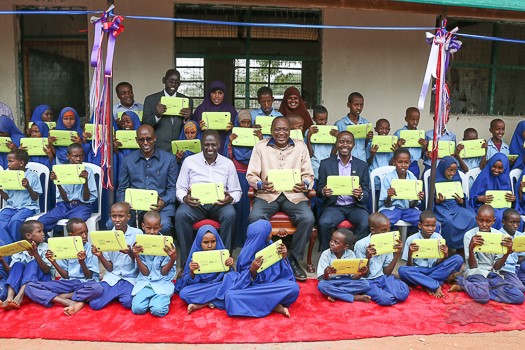
Getting laptops in the classroom was a big promise by President Uhuru Kenyatta and his deputy Dr. William Ruto. It was made during the Jubilee launch, Kenya’s current ruling party. The program has encountered challenges denying targeted beneficiaries access. Education expert Wesaya Jonathan, says challenges are a result of implementing the project without proper consultation.
“The handlers of the president and the bureaucrat at the ministry of education took the political pronouncement to implement it without making it a sound policy, without having worked on resource mobilization strategy, without working on how then the rest of the players in the education sector need to plug into it. So they start playing politics with sensitive issues and because it was political the resources were moving fast in the sense that nobody wants to let the president down,” he notes.
Mr. Wesaya adds that there ought to have been pragmatic approaches to be employed to realize the same dream at a lesser cost, progressively so that it makes sense and the logic behind it.
“DLP was not, is not, shall not be a reasonable investment for Kenyans even in the next decade from now. Because if it were that technology as a driver can be made for the masses, China and the USA would be the top countries where every child has a laptop in their hands but if they are the top producers and they are not doing it then Kenya needs to ask itself how it would have a laptop on every child’s lap” He challenges.
In his book titled “Politics of Manifestos” British political analyst, Dennis Kavanagh, makes it clear that the ability to carry out party manifestos lies at the heart of responsible government. Back in Kenya, political analyst Herman Manyora, says that there is no project that the government enters into unless if it is going to benefit a few people who put them in power. The few are then awarded government tenders and projects ones elected.
“DLP was nearly a political decision to get votes but it is also like any other government project intended to give people money to eat. Because if it is true they wanted students to be digital, they would have gone the tablet way which cannot go beyond a thousand shillings when loaded with content like the ones in Rwanda. Because you are buying them on mass which will be so cheap and they will cost Ksh. 2,000/ Ksh. 3,000 so they went the laptop way and it failed as obvious it was going to fail” Says Manyora.
According to 2020 Economic Survey, Kenya has approximately 16 million school-going children. This is equivalent to 1/3 of Kenya’s population. An economist at The Institute of Economic Affairs, Leo Kemboi, says instead of choosing DLP, the government could have ensured that the number of students matches the school facilities available. This could have benefitted learners directly.
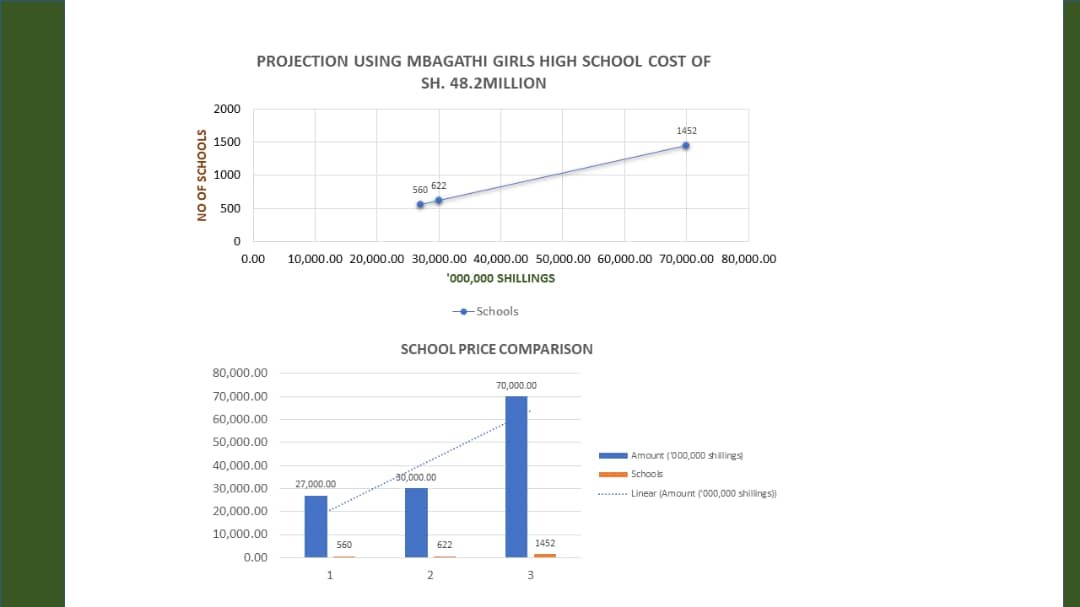
“The COVID-19 pandemic exposed the existence of inadequacies on school infrastructure especially limited classroom space, availability of water and sanitary facilities. By choosing to spend resources in the Digital Learning Program, when students are faced with myriad problems like lack of classrooms, Kenya made an inefficient trade-off. Building classrooms, sanitary facilities, stationery, books, and teachers sufficiently to meet the number of students can improve learning outcomes immensely,” recommends Kemboi.
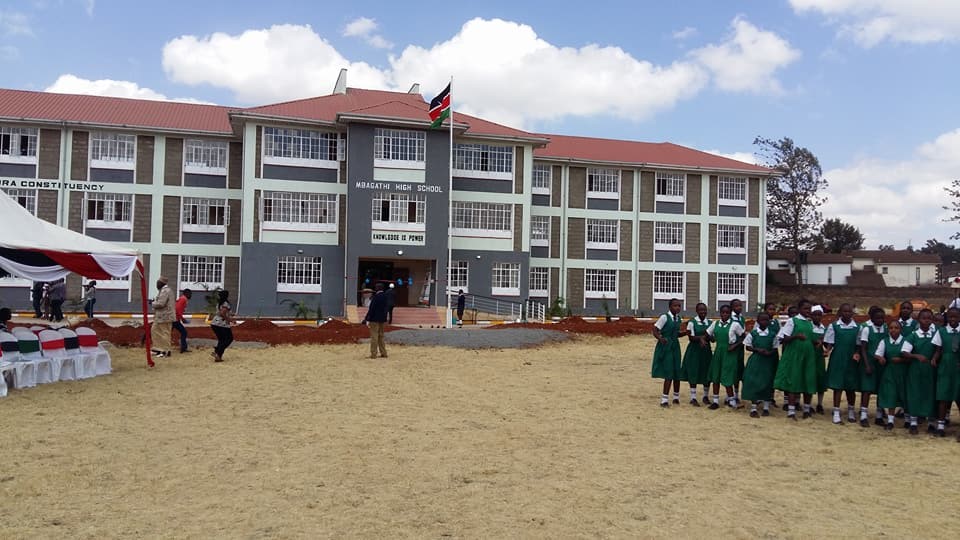
When the late Kibera Member of Parliament, Ken Okoth, launched Mbagathi Girls High school and had revealed that the school was built from scratch at a cost of KSh. 48.2 million. This, therefore, means that for each Ksh. 1 billion spent on DLP, 21 such kinds of schools would have been constructed countrywide.
KNUT Secretary General, Wilson Sossion, says money spent in the DLP would have hired enough teachers in the country.
“You only need KSh. 40 billion to bridge the shortage of teachers and the country could have employed the required 125,000 teachers,” he says.
The deficit of teachers was recently stressed by The Kenya Union of Post Primary Education Teachers (KUPPET) Secretary-General, Akelo Misori. On 4th May, he stated that about 25, 000 teachers are likely to retire by end of June this year.
In 2019, Kenya launched a 100% transition policy into secondary school for KCPE candidates. This process has widened the teacher-student ratio raising teacher shortage in public schools as many students are admitted compared to the number of new teachers employed.
The capitation grant provides recurrent funding to all public primary and secondary schools in Kenya. Currently, the grant is Ksh. 1,420 per learner for primary school and Ksh. 22,244 per learner for secondary schools.
A case in point is the rollout of the Ksh.30 billion plan for DLP which begun in June 2016. Had this amount been spent on capitation, then it could have benefitted 21.1 million learners in primary and 1.3 million students in secondary school.
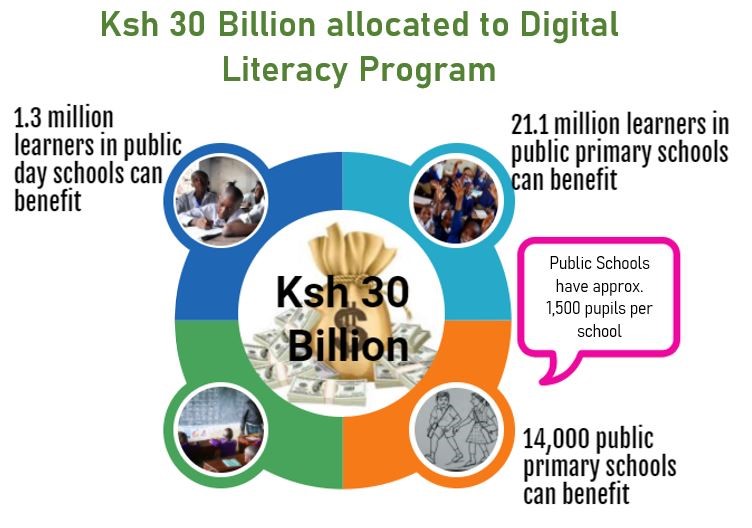
The examples above demonstrate huge opportunity costs foregone by the people of Kenya through DLP.
In 2018, in the audit report, the former auditor general, Edward Ouko, questioned the whereabouts of the Ksh.15 billion for the DLP.
While interviewed by the media, Dr. Kipronoh Rono, said “I am aware auditor general did an audit in ICT Authority and the report has been forwarded to parliament and I think a time will come when we will be called.”
Dr. Ronoh also admitted that some devices got lost in schools because of theft raising security concerns in schools.
Kenya has already allocated KSh.506 million in the current financial year for phase II of the DLP. The total implementation cost for the same phase is planned to be KSh. 64 billion. Jomo Kenyatta University of Agriculture and Technology (JKUAT) is the manufacturing plant while Moi University is the factory for the DLP.

